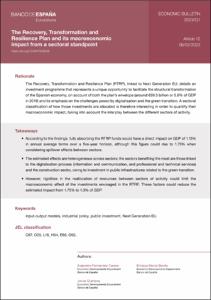Registro completo de metadatos
| Campo DC | Valor |
|---|---|
| dc.contributor.author | Fernández-Cerezo, Alejandro |
| dc.contributor.author | Moral-Benito, Enrique |
| dc.contributor.author | Quintana, Javier |
| dc.coverage.spatial | España |
| dc.date.accessioned | 2023-02-07T09:19:10Z |
| dc.date.available | 2023-02-07T09:19:10Z |
| dc.date.issued | 2023-02-06 |
| dc.identifier.issn | 1695-9086 (en línea) |
| dc.identifier.issn | 1130-4987 (en papel) |
| dc.identifier.uri | https://repositorio.bde.es/handle/123456789/29539 |
| dc.description.abstract | Rationale The Recovery, Transformation and Resilience Plan (RTRP), linked to Next Generation EU, details an investment programme that represents a unique opportunity to facilitate the structural transformation of the Spanish economy, on account of both the plan’s envelope (around €69.5 billion or 5.6% of GDP in 2019) and its emphasis on the challenges posed by digitalisation and the green transition. A sectoral classification of how those investments are allocated is therefore interesting in order to quantify their macroeconomic impact, taking into account the interplay between the different sectors of activity. Takeaways •According to the findings, fully absorbing the RTRP funds would have a direct impact on GDP of 1.15% in annual average terms over a five-year horizon, although this figure could rise to 1.75% when considering spillover effects between sectors. •The estimated effects are heterogeneous across sectors; the sectors benefiting the most are those linked to the digitalisation process (information and communication, and professional and technical services) and the construction sector, owing to investment in public infrastructures related to the green transition. •However, rigidities in the reallocation of resources between sectors of activity could limit the macroeconomic effect of the investments envisaged in the RTRP. These factors could reduce the estimated impact from 1.75% to 1.3% of GDP. |
| dc.format.extent | 11 p. |
| dc.language.iso | en |
| dc.publisher | Banco de España |
| dc.relation.ispartof | Economic Bulletin / Banco de España, 2023/Q1, 12 |
| dc.relation.hasversion | Versión en español 123456789/29538 |
| dc.rights | Reconocimiento-NoComercial-CompartirIgual 4.0 Internacional (CC BY-NC-SA 4.0) |
| dc.rights | In Copyright - Non Commercial Use Permitted |
| dc.rights.uri | https://creativecommons.org/licenses/by-nc-sa/4.0/deed.es_ES |
| dc.rights.uri | http://rightsstatements.org/vocab/InC-NC/1.0/ |
| dc.subject | Financial analysis |
| dc.subject | Monetary policy |
| dc.subject | Input-output models |
| dc.subject | Industrial policy |
| dc.subject | Public investment |
| dc.subject | Next Generation EU |
| dc.title | The Recovery, Transformation and Resilience Plan and its macroeconomic impact from a sectoral standpoint |
| dc.type | Artículo |
| dc.identifier.bdebib | 000474011 |
| dc.identifier.bdepub | ECBU-2023-Q1-12 |
| dc.subject.bde | Presupuesto y contabilidad pública |
| dc.subject.bde | Política industrial |
| dc.subject.bde | Métodos matemáticos y de programación |
| dc.publisher.bde | Madrid : Banco de España, 2023 |
| dc.subject.jel | C67 |
| dc.subject.jel | O25 |
| dc.subject.jel | L16 |
| dc.subject.jel | H54 |
| dc.subject.jel | E65 |
| dc.subject.jel | O52 |
| dc.identifier.doi | https://doi.org/10.53479/29539 |












